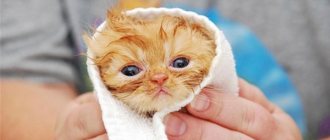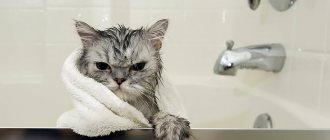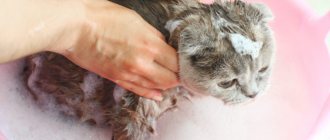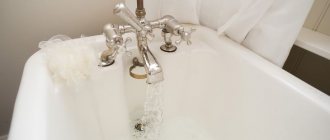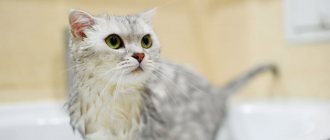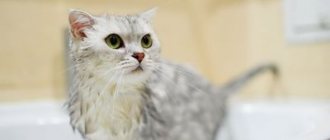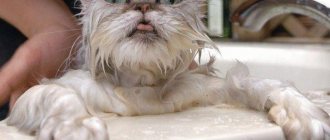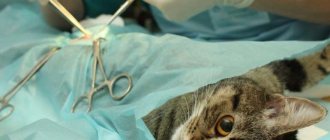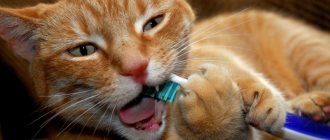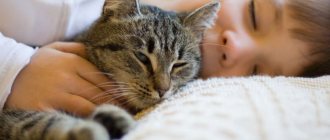Sometimes bathing a cat is a difficult and traumatic task, because most cats do not like it and perceive it as something disgusting or even a threat to life. They are trying with all their might to get out of the bathroom. Therefore, it is better to wash the cat, protecting your hands with knitted gloves, and getting an assistant. Even if it’s a child (not a very small one), the main thing is that someone holds the cat.
About the choice of mittens. It would be logical to take disposable latex gloves, but they will cause pain to the pet, crawling through wet fur. Therefore, choose knitted ones according to the type of construction ones.
Although there are also individuals who are tolerant of bathing and sit quietly in the bathroom while you fuss over them. But this is rare.
Rules for bathing a British kitten
What you need to know:
- When bathing a kitten, there is no need to rush anywhere, do not make sudden movements, hold it tightly;
- It’s most convenient to bathe your pet together, using a basin or sink (put a rubber mat on the bottom); the kitten may be scared of a large bath, and it will be easier to keep it in the sink;
- a basin or sink is filled with water a few centimeters, the water level should be just below the neck;
- to wash off the foam, it is better to avoid showering; cats, as a rule, are afraid of watering from a shower or tap, so it is advisable to do it yourself;
- While you are bathing the kitten, do not forget to talk to him, addressing him by name, your voice should be gentle and quiet.
How often should you wash your British kitten?
From the first day of life, the cat mother herself will monitor the cleanliness and carefully lick her kittens, so babies should not be bathed until 3-4 months, and temperature changes can negatively affect the health of recently born kittens.
But older and stronger animals can already be accustomed to water procedures. Moreover, if you start doing this at an early age, then problems with bathing are unlikely to arise in the future.
It is advisable to wash a British cat once every two months. But if the animal is heavily soiled or parasites are detected, it is necessary to arrange an unscheduled cleaning. If a small kitten goes to the toilet carelessly, climbs in somewhere and gets dirty, in this case it is also worth giving your pet a bath.
It is recommended to bathe your British cat more often during shedding; the water will wash away the falling hairs and then nothing will interfere with the growth of new hair.
But you shouldn’t get carried away with bathing cats. After all, even special bathing products wash away grease from a cat’s fur, which gives a healthy shine to its coat. Too frequent bathing will lead to dry skin, thereby making it more vulnerable to various infections and germs.
How to properly bathe a British kitten at home
Bathing water should not be hot (no higher than 37–39 degrees), the optimal temperature is in the range of 23–30 degrees.
If the apartment is cold (temperature below +15 degrees), then it is better to refuse a full wash. You should not pour water on the animal’s head; you can moisten it with a simple sponge.
If water gets into the kitten's ears, otitis media may occur; to avoid this, it is better to make cotton swabs and plug the ears with them while bathing.
The top of the tail, paws, belly and area behind the ears accumulate the most dirt.
These parts of the body need to be given special attention when washing
A wet kitten should not be allowed into a draft so that it does not develop a cold. After bathing, the pet's fur should be thoroughly dried, then the kitten should be wrapped in a terry towel.
And a few more simple tips
You cannot bathe your cat immediately after eating; the interval between the last feeding and taking a bath should be at least 4 hours; It is advisable for an active pet to have its claws trimmed before water treatments; cats are afraid of a hairdryer, and hot air is harmful to them, so after bathing it is enough to thoroughly dry the animal and release it; To protect your eyes from getting shampoo, it is recommended to apply a drop of Vaseline oil to their corners; if the kitten is shy, then you can try to switch its attention to something interesting - a favorite toy, or, for example, soap bubbles; After the bathing procedure is completed, the kitten should be praised and also treated with something tasty.
How to wash a British kitten?
To wash cats, shampoo should only be purchased at pet stores. Ordinary shampoos and soaps are not suitable for animals, since their skin is much more sensitive than human skin and the pH value differs from the human pH.
After bathing, the cat will definitely begin to lick itself, so the shampoo must be rinsed off the fur very well. While bathing, apply foamed shampoo to the kitten's fur and rub it into the skin with gentle movements.
If the cat categorically does not tolerate water, then you should not insist on bathing; for such picky cats there is an alternative that will replace regular washing - this is dry bathing.
For these purposes, dry shampoo is purchased, sprayed onto the cat’s fur, and then the powder, which has absorbed all the dirt, is thoroughly combed out. True, this pleasure is not cheap, but the kitten will not be stressed, and its fur will become clean.
Bathing a British kitten is not difficult at all. After bathing, the animal should be left alone for a couple of hours; perhaps your kitten will hide in some corner of the apartment, do not jerk it, over time it will calm down and come out to you on its own. Shiny and clean fur will be your pet’s reward for his patience.
British haircuts
Lovers of British breed cats are divided into 2 types:
- The first of them believe that pets need to be cut regularly. They explain this by the fact that a short-haired Briton leaves much less hair in the house, and also by the fact that it is difficult for animals with a thick undercoat to tolerate the heat. Some of them simply want their trimmed pet to stand out from others or have its own style.
- The second category of British lovers is categorically against cutting, since they consider the coat of this breed to be the main advantage, which in no case should be spoiled.
There are so many people, so many opinions, so it’s impossible to say for sure whether grooming can be done this way.
But if you still decide to cut your British cat’s hair, use a few tips:
- The procedure should only be carried out by a professional technician who is well acquainted with the anatomy of cats. Do not try to trim the animal yourself - you may injure it or introduce a dangerous infectious disease!
- Make sure that the haircut process takes place in a calm and friendly place, without the use of force. The pet should not suffer psychological trauma.
- Pay attention to how other cats are groomed in front of you - cats should not take any sedatives before the procedure.
- A qualified master must be able to find an individual approach to any animal. Your Briton's behavior will tell you whether he liked the master. In good hands, a cat will never behave aggressively.
In fact, it is not so important whether your pet will have a haircut or not - the most important thing is that the cat has a neat or even smart appearance.
Take care of the health of your British cat, pay him as much attention as possible. Caring for a British dog is not as difficult as it might seem at first glance. An animal that feels love and care will never remain in debt to its owner!
More articles on this topic:
You will need
- - rubber mat;
- — shampoo for cats;
- — tint shampoo for animals;
- — 2-3 towels;
- — silent hair dryer;
- - powder for grooming.
Instructions
A British cat should be washed at least once every 3 months. Light-colored animals are washed more often than dark-colored ones. Do not use human shampoos as pH levels are different between cats and humans and may harm the animal's skin and coat. Buy special products based on seaweed and medicinal herbs.
You can wash your cat in a sink or basin, but it is better to use a bath. In this case, you have a better chance of protecting yourself from bites and scratches. Be sure to place a rubber mat on the bottom of the bath that your cat can claw onto. Turn on the shower in advance. The jet pressure should be average, the temperature should not exceed 40 degrees. Pour in a small amount of water.
Gently lower the cat into the bath. Holding by the shoulders, wet the fur - first the back, then the sides, tail and hind legs, and then the belly, chest and collar area. There is no need to wash your cat's hair. Make sure that water and shampoo do not get into her eyes and ears. Lather the wool in the same order in which you wet it. Don't apply too much shampoo as it will be difficult to wash it off.
The cat should be washed twice. When washing for the second time, use special tinted shampoos for animals that match the color of your pet. Leave it on for 2-3 minutes and then rinse off. Rinse the animal's fur thoroughly and rinse with a special cat rinse or a weak vinegar solution.
Wrap the cat in a towel and transfer it to the table. Wipe down the animal. British cats have a very dense undercoat, so you may need not just one, but 2 or 3 towels. The drying process can be speeded up by using a silent hair dryer, which must be turned on in advance. This will help your pet adapt faster. If the animal is very frightened and it is impossible to dry it with a hairdryer, use a special grooming powder. It will absorb water and make the coat silky. You cannot leave a cat wet - it may catch a cold. A few hours after bathing, treat the animal's fur with a protein spray.
Loving owners of their pets are wondering whether British cats need to be washed and what is the correct bathing procedure for British kittens. Questions about hygiene are important not only for people, but also for animals. After all, you want to stroke and pick up a clean and well-groomed cat. Also, if you do not bathe your pet, the risk of contracting a disease or infection increases. Remember that there are special rules for doing this.
British cat hair care
The famous plush fur of the British cat evokes a lot of positive emotions from simply touching it. But to achieve such a result, the owner has to properly care for his pet.
The main principle of care is to remove guard hairs as thoroughly as possible with minimal trauma to the thick undercoat. To do this, the cat is combed according to the growth of the hairs, periodically changing direction. First of all, scratch the back, sides and chest of the animal, and then move on to the paws, tail and muzzle. The necks and chubby cheeks of the British Shorthair are always combed against the grain.
By the way, representatives of the British breed are one of the few who enjoy this procedure - they begin to purr loudly and prop up their back to continue the massage.
How to brush British cats
- An ordinary metal comb with medium-frequency rounded teeth. It is advisable for her to comb the British first, slowly and strictly in the direction of hair growth.
- Rubber massage brush or slicker brush. This is an excellent option for brushing British cats without electrifying the hair. It is recommended to brush the animal vigorously with such a brush, massaging all areas of the body.
Some cats love to swim
Within each breed there are such individuals. And there are breeds that tend to splash around in the water with pleasure. These are mainly breeds that are closer to nature. For example, Bengals. They have a great time playing water games and are not averse to taking a full swim. But Scottish cats are not bath lovers.
The British have an instinct for cleanliness at the genetic level. But in order to achieve lasting and positive results in the behavior of these pets, it is very important to raise them correctly. In this article we will tell you what is needed to keep a British cat in an apartment, how to train him to use a litter box, and also how to wash and comb British cats. By following the basic rules of caring for the mustachioed inhabitant of the house, you will raise a truly luxurious animal with the manners of an aristocrat.
What does a British cat need in an apartment?
Before bringing your Briton to a new place of residence, prepare all the necessary accessories for him:
- Sleeping area.
Decide in advance where your pet will sleep. Representatives of the British breed are quite independent and like to be alone, so it would be advisable to buy your pet its own bed or cat house. - Tray.
For the toilet, it is better to use a closed plastic tray. When purchasing, you should take into account the large dimensions of the British - the tray should be high and as comfortable as possible. It is better to use silica gel or wood filler; they absorb moisture well and prevent the occurrence of unpleasant odors. - A bowl.
A special drinking fountain or ceramic bowl is perfect for water. And for food, you should choose a tall metal bowl with a wide bottom. - Scratching post.
British cats do not want to spoil your furniture at all, they just love freedom very much. However, we all know how dangerous the street is for purebred animals. In order for your pet to be able to independently care for its claws in the apartment, it needs to purchase a scratching post or a play set. - Comb.
For the plush fur coat of the British, massage slicker brushes or oval rubber combs, which can remove static electricity, are best suited. - Cloth.
An additional accessory for your pet can be cool clothes that will not only emphasize the important appearance of the British cat, but will also warm you up during a walk in the cold. After all, short-haired cat breeds have a hard time withstanding frosty winters. Clothing for a British person should be comfortable, high quality and easy to wash.
Create a cozy atmosphere for your pet in your home, and then he will be able to feel at ease.
How to bathe a cat?
In pet salons, masters use dozens of means and methods to groom your pet, but it’s simplified and one or two will be enough for you.
The first rule is that you cannot bathe your cat with shampoos for people or products for dogs - they can be dangerously toxic for your pet. Pet stores offer many special ones - choose one that matches the type of your animal.
Shampoos for cats:
- Sprays – clean the animal’s fur and work as antistatic agents;
- Dry shampoos – powder (dry) products are suitable for cats that have not overcome hydrophobia;
- Liquid is the most common form for cats that have overcome their fear of water.
Industrial bathing products - popular brands
Manufacturers offer conventional cleansing shampoos and bathing products with targeted action: against dandruff, against allergies, against hair loss, against fleas, and lichen.
Popular brands:
- Beaphar Shampoo Hypo-allergenic – hypoallergenic shampoo.
- VEDA Phytoelite is an anti-matt shampoo for fluffy cats.
- CLINY – shampoo-conditioner.
- Beaphar Shampooing Chats & chatons – for cats and kittens.
- Bio-Groom “Klean Kitty” – spray shampoo.
- Ms Kiss “Freshness and Volume” – dry shampoo.
- Mr.Gee – dry shampoo with mint.
- Beaphar Shampoo Anti Dandruff - anti-dandruff shampoo.
- RolfClub – insecticidal shampoo.
- Beaphar Shampoo Anti-Itch – anti-itch shampoo.
At what age can British dogs be bathed?
A cat of noble blood needs washing at an early age more for beauty than for cleansing. After all, before an exhibition you need your fur coat to look well-groomed and shiny. A kitten can be bathed from three months
, if he has a long or thick coat and undercoat. Some veterinarians recommend starting no earlier than five months of age. This includes Persian, British, Scottish and other breeds.
Washing will bring many benefits:
- firstly, it will teach the baby to discipline;
- secondly, bathing allows you to remove static electricity from hairs;
- thirdly, it will remove dead epithelial scales and hairs, as a result, less of them will end up in the pet’s mouth and stomach.
Visit to the veterinarian
When purchasing a pet, you should carefully read the reviews of visitors to nearby veterinary clinics and choose the right one.
The first vaccination for a kitten is given at 12 weeks.
If British breed kittens are cared for correctly, visits to the veterinarian will not be frequent, but kittens should be seen regularly for examinations and vaccinations during the first year of life.
- Vaccination schedule.
Until a kitten that feeds on its mother's milk is 12 weeks old, there is no point in getting vaccinations, because... With milk he receives antibodies that enhance immunity.
When the kitten is one year old, he is vaccinated against rabies.
At 12 weeks, the baby receives the first comprehensive vaccination, which includes components against rhinotracheitis, calcivirosis, and panleukopenia. The vaccine is fixed exactly after 21 days with a similar composition. When the kitten is one year old, he is given the same vaccination for the third time, and a rabies vaccination is added to it.
Caring for British kittens includes preventive deworming
In the future, the pet is given a comprehensive vaccination and vaccination against rabies every year. Even if the cat is constantly in the apartment, annual vaccination should not be neglected.
- Deworming.
Caring for British kittens includes preventive deworming.
Deworming is mandatory before vaccinations. The procedure must be carried out 10 days before vaccination; the drug can be in the form of a tablet or suspension.
If lice, fleas, scabies mites or lice mites are found on a kitten, it is necessary to treat it with drugs against ectoparasites
Until the kitten is six months old, deworming is carried out monthly.
Once the pet reaches one year of age, worming is carried out once a year.
- Treatment against ectoparasites.
If lice, fleas, scabies mites or lice mites are found on a kitten, it is necessary to treat it with drugs against ectoparasites. The products are available in the form of sprays, powders, drops on the withers - the veterinarian will select the most effective one, because For kittens under 3 months of age, only short-acting medications can be used.
For kittens younger than 3 months, only short-acting medications can be used.
How to bathe a kitten correctly?
To solve the problem of how to wash a kitten, you need to be well prepared. You should not engage in water procedures immediately after eating; make an interval after lunch or breakfast for about 2-3 hours. It is advisable to shorten the animal’s claws the day before and use a comb to remove any tangles that have formed.
If the baby is scared, then distract his attention with games. For those who do not have much experience in bathing a kitten, it is recommended to close the bathroom door tightly; a wet little lump can run away, become hypothermic and get very stressed.
How to properly bathe a kitten for the first time?
Babies, not yet accustomed to water procedures, are capable of scratching, screaming, and trying to break free. It is better to wear a shirt with long, closed sleeves to protect yourself from scratches. Place all the necessary equipment at your fingertips; running around looking for shampoo or a towel with a baby screaming in fear is extremely inconvenient. When it comes to bathing small kittens, it is better to be calm and patient. Do not plunge your baby into the water right away, play with him in a dry bath or sink, turn on the pressure gradually, wetting the fur on your pet.
How to bathe a kitten correctly:
- To bathe animals, you can use a bathtub, sink, comfortable basin or other container firmly installed on the surface.
- We must not allow liquid to get into the ears; we try to cover the body with water up to the neck.
- We carefully monitor the baby’s behavior, avoid contact with his sharp claws, and do not let the pet escape.
- Most of the dirt accumulates under the grip and paws.
- Wet the kitten's fur and apply shampoo.
- We wait a couple of minutes.
- We bathe the animal until the remaining detergent is washed off.
- We dry the kitten by carefully wrapping it in a towel.
- In winter, you can speed up the drying process with a hairdryer.
If the bathing procedure is performed incorrectly, the kitten develops a persistent feeling of fear of water. Often he is frightened by an unstable basin or a powerful stream of liquid from a tap; the owner’s screams or his rude actions can traumatize his psyche. Having plunged headlong, the pet will take water into its ears and choke. The first bath is an important experience that will leave an impression on the kitten for life, so try to do it well.
At what temperature should you bathe a kitten?
Beginners are always concerned with the most important question: at what temperature of water can a kitten be bathed. Hot or too cold liquid can frighten the baby, cause illness from hypothermia, or lead to burns. We make the temperature of the liquid as close as possible to the pet’s body temperature; for a cat it is about 38°C-40°C. In such an environment, the animal feels comfortable and tolerates water procedures more calmly.
We try not to use human shampoos or strong drugs intended for treating dogs on cats. While pH5.5 is great for humans, cats need products with pH7.5. When thinking about the topic of how often and at what age you can bathe kittens with shampoo, do not forget about the work of the animal’s sebaceous glands. Liquid solutions more strongly wash away the protective natural substances responsible for antibacterial protection from the skin, so they cannot be used frequently. Regardless of the composition of shampoos, they must be completely removed from the coat with warm water.
Popular shampoos for cats:
How to bathe a kitten for fleas?
When thinking about whether it is necessary to wash a kitten after, you need to remember that vaccinated animals have weakened immunity for some time after the medical procedure. Slight hypothermia or any draft can provoke a serious illness. Flea shampoos can provoke an undesirable reaction at this time; you should refrain from using them. It is advisable to keep the animals in the room for the first time after vaccination, without letting them out into the yard, and to postpone the planned bathing for a couple of weeks.
When a kitten appears in the house, many questions arise.
What to feed the baby? How to train to a tray? Where to arrange a sleeping place? At what age can kittens be bathed? It is so important to keep the animal's fur clean. Previously, the cat’s mother watched over this, and he himself had not yet learned how to perform hygiene
The kitten will remember the first contact with water for a long time, so you need to take the process seriously.
If your pet still has negative emotions, then next time he will fight back hard: scratching, biting and struggling with all his might. That's why you need to turn bathing not only useful, but also a pleasant pastime.
Some breeders claim that a kitten can be washed from the age of one month. This is explained by the fact that such a baby practically does not resist and does not scratch. But it’s not worth risking the baby’s psyche, because any unknown procedure is a great stress for him.
Basic rules for washing kittens
It is better to keep the doors to the bathroom closed, because if the cat runs away from you, you will not need to look for it throughout the apartment.
It is necessary to wash the cat with confident movements, which include:
- The most important point is to place the animal in the bath; it is better to grab it by the scruff of the neck, so that it does not have the opportunity to scratch, break free and run away. Before you start washing the kitten, you need to wet its fur and keep its nose and ears dry. To avoid irritation, you should put eye drops in your pet's eyes and plug his ears with a tampon. Water should not get into the cat’s nose and ears, otherwise inflammatory processes may occur.
- It is most convenient to wash a kitten in the shower; this procedure will result in less splashing, and the animal will more easily endure such an ordeal. You can hold the cat with your left hand, and the shower with your right.
- The shower must first be put aside, and the shampoo must be applied to the back, paws and tummy of the pet, do not forget about the tail.
- Last but not least, you can wash the baby’s head, because this is the most unpleasant part of this procedure.
- A soft sponge should be used for washing.
- The easiest way to wash off the foam is with a shower from top to bottom, but you need to make sure that water does not get into the cat’s ears.
- After the pet has taken a bath, all the foam has been washed off, it must be placed in a warm towel. It is best to use two towels, and one of them must be thick, because it is unknown how the cat will behave after washing.
- You should not bathe your pet after he has eaten. The bath should be used no earlier than 4 hours after eating.
If the kitten has survived vaccination, then it will be possible to wash it no earlier than after 2 weeks.
The ABCs of Bathing
Considering the risks that water treatments can cause to animals, they should be approached responsibly. Any deviation from the rules can lead to dermatological or colds.
First bath
In order not to traumatize the baby’s psyche, the first water procedure should be as comfortable as possible. The quality of its implementation determines the attitude towards subsequent bathing.
You need to get used to water from an early age. At 3 months, the kitten can already have a bath day. Before this, responsibility for the cleanliness of the pet lies on the mother's shoulders. If he is very dirty, he can be given a bath even at 1 month of age.
Frequency of bathing
Considering the love of the feline family for cleanliness, washing should be an auxiliary activity, but not the main one. Frequent bathing has a negative impact on the condition of the coat.
Before you begin water procedures, you need to familiarize yourself with the advice of experienced cat owners and veterinarians. To make this event comfortable and not cause harm, it is advisable to adhere to the following rules:
- Wash on an empty stomach or after a small snack.
- Avoid contact with water for 14 days after vaccination or if you have ringworm.
- It is advisable to adjust bathing to seasonal molting. During this period, pets lick themselves more often, which is fraught with accumulation of hair in the stomach and disruption of digestive processes.
- Pedigree animals are given unscheduled baths before participating in exhibitions.
- If the cat is very dirty and is unable to cope on its own, an additional bath day is arranged.
Some owners use the services of groomers for their first bath. Such a service costs about 400-600 rubles and allows you to learn all the intricacies of the procedure.
Strategically important places
Some parts of kittens' bodies get dirty more than others.
During the bathing process, special attention should be paid to the following areas:
- armpits;
- behind the ears;
- stomach;
- paws;
- anal area.
Animals' ears also get very dirty, but they can be cleaned with cotton swabs.
Detergents
The kitten hair care line is presented in several versions - shampoos and conditioners for normal, dry, oily and damaged skin. Since kittens have more delicate skin and fluffier fur than adults, they need gentle products.
Based on consistency, washing cosmetics are divided into 3 groups:
- Liquid.
This category includes soap-based shampoos and conditioners. Most in demand. - Powdery.
Indispensable for pets afraid of water. Applying cleansing powder is more labor-intensive, but relieves the kitten from a stressful situation. Not suitable for animals with dark fur. - In the form of sprays.
A convenient sprayer allows for precise application of the product. Helps with partial bathing and for working with tangles.
Dry shampoo can be made at home. To do this, mix equal parts baby powder and cornstarch.
Table 1. The best shampoos for bathing kittens
Rules of application:
When choosing detergents, you should take into account the type and color of the coat, as well as the condition of the skin. Shampoos for long-haired kittens are not suitable for pets with short hair and undercoat. Detergents have different PH levels, which directly affects the silkiness and grooming of the coat. If for humans they are designed for an acid-base balance of 3.5 to 4.5 units, then for cats you need to look for products with a pH of 6.5. It is preferable to buy concentrated shampoos
They are more expensive than regular ones, but they are more economical in consumption. Herbal shampoos are not used for silver, white and blue kittens. Siamese and Abyssinian babies are not recommended to use care products to create volume. You need to purchase specialized products designed for cats or for cats and dogs. The use of exclusively dog shampoos is possible only before participating in exhibitions. Most detergents need to be left on the wool for up to 7 minutes. This is especially true for medicinal products. It is not advisable to use 2-in-1 shampoos and conditioners. Human cosmetics are not suitable for kittens because they kill the skin’s defenses.
The best conditioners for bathing babies are those produced by Tropiclean and Iv San Bernard.
How to wash a cat for the first time?
You need to wash a kitten for the first time when it is still small - at about 2 months. Before that, wipe it with a damp towel and comb its fur. This is necessary so that the pet gets used to this procedure and subsequently feels calm in the bathroom. It also teaches cleanliness. It is important to wash British kittens thoroughly in order to get their fur in order, because kittens are not able to do this on their own. There may be fleas in the fur, and you also need to get rid of them. If this was not possible after the first bath, repeat the procedure a week later.
Estrus and mating features of British cats
British cats are fully mature at 7-9 months. Young animals should be bred no earlier than 10-12 months, having missed the cat’s first two heats. This is due to the fact that the body is not yet fully strengthened, and complications are possible during pregnancy and childbirth.
A two-year-old cat becomes hot-tempered and often shows aggression towards the cat. In general, during the period of estrus, cats exhibit specific behavior:
- she often chooses to communicate with the owner rather than with the mistress;
- becomes demanding of attention - caresses, rubs against legs, shoes;
- shows excessive affection, becomes intrusive;
- the back bends, the hind legs move, the tail moves to the side;
- the animal meows obsessively and licks the genital area.
The acquaintance of a cat and a cat may not always be ideal, and if the cat has a character, then you will have to look for another “groom”
The duration of estrus in British cats varies around 7-10 days. If the cat has not been fertilized, then the repetition of estrus occurs on the 15-20th day. Sex Barrier drugs and other contraceptives negatively affect the health of the animal, creating hormonal imbalance and developing tumors.
Acquaintance between a cat and a cat can take place in different ways, depending on the characters of both animals. At first, the cat may categorically not accept the cat, but when the acquaintance goes well, it can occur from 15 matings per day, and the cat’s temperament is already taken into account. Two days will be enough for mating cats; during this period, the cat can safely impregnate the cat.
During sexual heat, the cat’s behavior changes, it becomes affectionate, intrusive and loudly calls for the cat
If estrus does not occur within three weeks, we can assume that everything turned out well and the cat is pregnant. It is better to breed experienced animals or at least one of the pets should have mating experience, otherwise the fertilization process will take a lot of time, and without the help of the owners the process will not be successful.
British cats are smart animals with character
A little about the breed
It is believed that British Shorthair cats trace their ancestry back to the famous Cheshire cat. But seriously, this is one of the first officially recognized and standardized breeds: already at the first London cat show in 1871, the British were widely represented.
British cats have dense, plush fur.
British Shorthair cats have a strong build, developed pectoral muscles, a short thick tail, strong dense legs and a round massive head. A captivating feature of their appearance is their thick cheeks and round amber eyes. Another distinctive feature of the breed is its dense, plush coat. More than 60 color variants are recognized, but the main ones are lilac and blue.
British cats have round amber eyes
• the cat got dirty in the mud; • a toxic substance got on the fur; • fleas appeared; • the fur has a tendency to quickly become greasy.
In all other situations, it is preferable not to torture the animal. Cats don't like to swim. Frequent washing leads to the fact that the protective layer is washed off, as a result the animal can get sick.
Food for British kittens
The main thing in the nutrition of British kittens is to have enough protein
Proper nutrition is the key to animal health and longevity. The British eat both ready-made food and home-cooked food with equal pleasure. When purchasing a British breed kitten, ask the breeder what kind of diet he had. If the kitten ate ready-made food, and you plan to feed it homemade food, gradually switch to a different food.
Their diet should contain enough protein to help them gain breed-specific muscle mass. The daily amount of food is calculated empirically; all kittens eat differently.
What can you include in a kitten's diet?
dairy products: cottage cheese (not fatty), sour cream or kefir (fresh only); boiled egg yolk 1-2 times a week; boiled chicken white meat or beef in the form of minced meat; boiled fish without bones (rarely, to pamper); boiled offal: beef heart or kidneys, chicken navels - 2-3 times a week; porridge - oatmeal, wheat or rice. you can add vegetables to the meat - cauliflower or carrots
Give carrots carefully and in small quantities - they can affect the color of the animal... Read more about how and what to feed a British breed kitten here
Read more about how and what to feed a British breed kitten here.
What foods should you avoid?
- milk or cream may cause loose stools;
- pork is too heavy food for a kitten;
- chicken skin is not digested at all by a cat’s stomach;
- raw fish, as well as frequent consumption of boiled fish, causes urolithiasis.
- dishes prepared for yourself - they contain sugar, salt, spices, which are contraindicated for kittens;
- fatty, smoked or fried foods;
- potato.
Dishes for kittens
Don't buy double bowls for food and water. Pieces of food will constantly fall into the water, making it stale.
Immediately after feeding, wash the cups, discarding any uneaten food. Do not give kittens stale foods or foods that are not fresh.
Feed small 2-3 month old kittens 4 times a day, transfer teenagers to three meals a day. Change drinking water once a day.
Ready-made feed
Feed British breed kittens with premium food
Premium ready-made food is suitable for British kittens. It is better to feed babies with canned food; teenagers can already alternate dry and wet food
Pay attention to what age the food is intended for
Vitamins and feed additives
Homemade food does not always contain all the necessary vitamins for healthy growth of a kitten. For good hair, you can add brewer's yeast to your food. Excellent vitamin complexes would be Hartz, 8 in 1 Excel Brewer's Yeast or 8 in 1 Calcidee. They contain the calcium and B vitamins cats need.
Use vitamins containing seaweed with caution. For chocolate and red kittens, they will add richness to the color of the fur and eyes, but for lilac-colored cats they can give a pinkish tint.
Give the number of tablets in accordance with the age and weight of the kitten, which is indicated in the instructions.
How to bathe correctly for the first time?
It is better that the weather outside is good and the room is warm and dry. The kitten must be completely healthy and not hungry. It is advisable that the baby is not in a playful mood.
How to bathe a kitten for the first time? To do this you need:
- Prepare a large soft towel, shampoo and a small basin. Place a stool in the bathroom with a basin on top or place the basin in the sink. Wear an apron and old clothes, as the kitten can tear them. The right thing to do would be to open the shampoo right away.
- Turn on the shower and set it to low pressure. Make sure the water is warm. You need to test it on the elbow bend. If the water is warmer than room temperature, you can burn your pet. The fact is that its receptors are different from human ones. Pour some water into the bowl, about 2 cm from the bottom.
- Form two small balls of cotton wool and grease them with vegetable oil. Place them in your pet's ears to prevent water from entering. The kitten will also be protected from splashing and noise.
- With your left hand, grab your pet by the withers (the place where a cat grabs kittens to move them to another place). Check if everything is okay with him and put him in a basin. The pet can be in any position - lying or standing. The main thing is that he holds tight.
- Without letting go of your hand, take the shower in your other hand and wet your pet’s fur. Start from the neck area and slowly work your way down and back towards the tail. It is important to follow this sequence, as it is better for the fleas to run from the water to the tail, and not into the eyes.
- There is no need to wet your head, especially your ears and eyes. You can simply run a wet hand over them without using a shower. Don't forget about another goal - not to scare your pet. You need to talk to him calmly, reassure him.
- Pour a few drops of shampoo into your hand, lather and apply to the coat. You need to do this with one hand, since you cannot let go of the kitten. Distribute the foam over the entire skin, making sure that all areas are affected.
- Looking at the instructions, leave the shampoo for two minutes, then rinse. This must be done at high speed, but do not forget about caution. Leave the direction the same. See if there is any foam left.
- Wrap your pet in a towel, allowing him to move his head and breathe. First, just hold it, then start gently wiping it.
- After 5 minutes, you can free him from the towel and let him out on the sofa to lick himself. Avoid drafts and soap residue on the fur, which the kitten can lick off.
You should not use a hairdryer.
If the bathing went perfectly, this can ruin everything. A hairdryer is like a vacuum cleaner for your pet and can be very frightening for your pet.
If your pet is fairly clean, but very timid, you can wash only its paws or butt with napkins or a damp towel. After the procedure, you can give your pet his favorite food so that he has pleasant memories.
